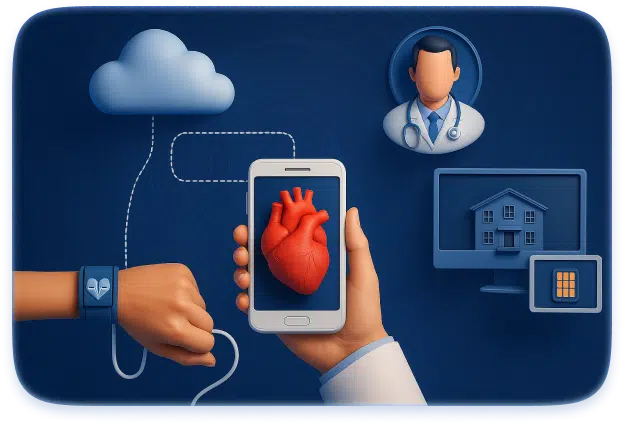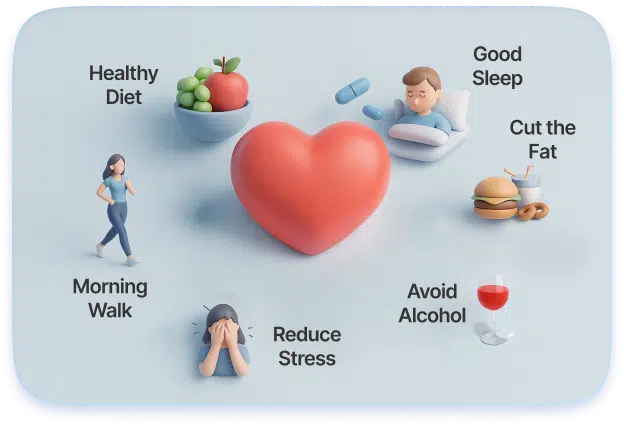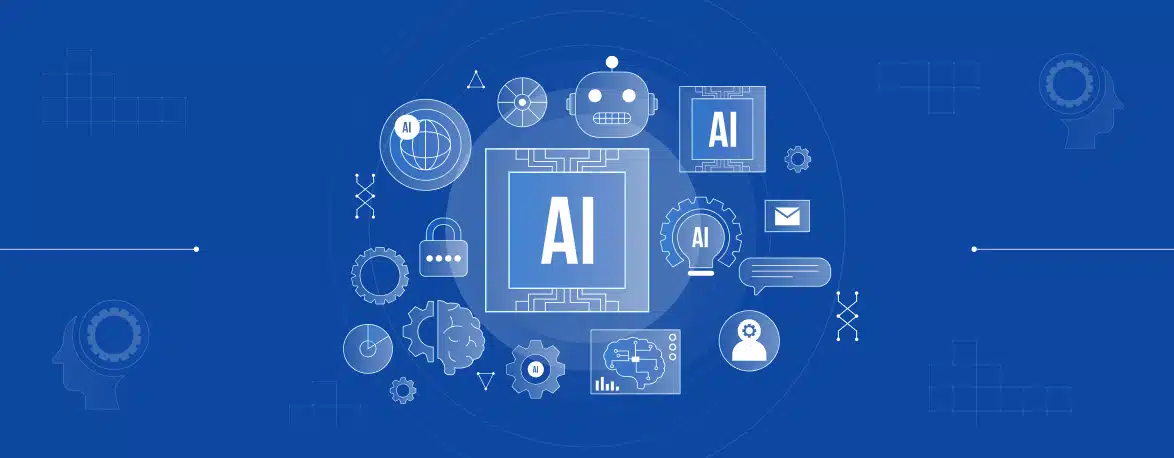- A Basic Idea of Reactive Healthcare
- The Rise of Proactive Healthcare
- Key Differences Between Reactive and Proactive Healthcare</a/>
- Why the Shift to Proactive Healthcare Matters?
- The Innovative Benefits of Proactive Healthcare
- How Technology is Powering Proactive Healthcare?
- 1. Wearable Devices
- 2. Telehealth Services
- 3. Health Apps and Digital Platforms
- 4. Predictive Analytics and Data Modeling
- Lifestyle Modifications in Adapting Proactive Healthcare
- Challenges in Implementing a Proactive Healthcare Approach
- A Healthier Future Through Proactive Healthcare, Powered by AI!
Proactive healthcare, powered by wearable technology and AI, shifts the focus from treatment to prevention for better health results and reducing costs.
Healthcare is at the center of a major transformation. For years, the tradition (especially in India) has been reactive healthcare, where treatment starts only after symptoms appear. But now, with rising healthcare costs, an aging population, and the increasing prevalence of chronic diseases, this reactive model is becoming unsustainable. The focus is shifting toward proactive healthcare, which emphasizes prevention, early detection, and continuous health management.
The shift is being driven by advancements in technology, allowing individuals and healthcare providers to take control of health long before problems arise. Find out the actual differences between reactive and proactive healthcare and how technology assists in building a healthier, more resilient future.
A Basic Idea of Reactive Healthcare
Most of us are familiar with reactive healthcare. It’s a model where you go to the doctor only when symptoms appear, such as a fever, a cough, or an injury. Reactive healthcare works in cases of acute conditions or emergencies like infections, fractures, or cuts. But, falls short for chronic diseases like diabetes, heart disease, or hypertension. By the time these conditions are diagnosed, they might already have caused damage and treatments may be required for the rest of a person’s life.
In this model, prevention and early intervention are not prioritized. It’s more about treating symptoms as they arise and responding to health problems after they’ve occurred. While reactive healthcare is necessary for dealing with emergencies, it is not enough to help manage long-term health.
The Rise of Proactive Healthcare
Proactive healthcare takes a different approach. It focuses on prevention, early detection, and continuous health management. Rather than waiting for symptoms to appear, proactive healthcare encourages regular check-ups, screenings, and lifestyle modifications aimed at improving overall health. The goal is to identify risks early and take action before they become serious health issues.
For example, if a patient is at risk of heart disease, proactive care would recommend regular cholesterol monitoring, exercise, and dietary adjustments. The objective is to prevent heart disease from developing or worsening, rather than simply treating it after it’s been diagnosed.
Key Differences Between Reactive and Proactive Healthcare
To better understand the differences, let’s compare these two models side by side:
| Aspect | Reactive Healthcare | Proactive Healthcare |
|---|---|---|
| Focus | Addressing health issues as they arise | Preventing health issues before they arise |
| Approach | Treating symptoms | Identifying risks and intervening early |
| Health Monitoring | Limited to when symptoms are present | Continuous monitoring and regular check-ups |
| Costs | Higher costs due to late-stage interventions | Lower costs due to early prevention |
Focus
Reactive Healthcare:
- Addressing health issues as they arise
Proactive Healthcare:
- Preventing health issues before they arise
Approach
Reactive Healthcare:
- Treating symptoms
Proactive Healthcare:
- Identifying risks and intervening early
Health Monitoring
Reactive Healthcare:
- Limited to when symptoms are present
Proactive Healthcare:
- Continuous monitoring and regular check-ups
Costs
Reactive Healthcare:
- Higher costs due to late-stage interventions
Proactive Healthcare:
- Lower costs due to early prevention
Why the Shift to Proactive Healthcare Matters?
Proactive healthcare takes a more holistic view of health. It recognizes that factors like genetics, lifestyle, environment, and even social conditions play a role in determining overall health. A proactive approach to healthcare enables individuals to take control of their health and make informed choices to maintain well-being.
One of the major advantages of proactive healthcare is the collaboration it fosters between patients and healthcare providers. Rather than solely focusing on diagnosing and treating illnesses after they happen, healthcare professionals work closely with patients to create personalized health plans that prioritize wellness and prevention. The transition towards collaboration empowers individuals to take ownership of their health.
The Innovative Benefits of Proactive Healthcare
- Early Detection and Intervention: Proactive healthcare allows for the early detection of potential health problems. Regular screenings and tests like blood tests, can identify issues like diabetes or high cholesterol before they develop into more serious conditions. For example, routine blood tests can catch signs of diabetes early, enabling patients to make lifestyle changes and manage the condition before it progresses.
- Cost Savings: While proactive healthcare may seem more expensive upfront, it can lead to substantial savings in the long run. Preventing diseases before they occur or catching them early helps avoid expensive treatments, hospitalizations, and long-term care. Such an approach reduces the overall financial burden on both individuals and healthcare systems.
- Improved Quality of Life: Engaging in proactive healthcare leads to better physical and mental well-being. When individuals actively manage their health, they are more likely to make healthier choices, such as exercising regularly, eating balanced meals, and reducing stress. It helps them avoid illness as well as contributes to a higher quality of life.
- Chronic Disease Management: Proactive healthcare is crucial for managing chronic diseases like diabetes or hypertension. By continuously monitoring health metrics and adjusting treatment plans as necessary, healthcare providers can help patients stay on top of their conditions. This reduces the risk of complications and ensures that individuals maintain control over their health.
How Technology is Powering Proactive Healthcare?
Advancements in technology are playing a central role in facilitating the shift toward proactive healthcare. Here’s how the latest tech tools are supporting this transition:
1. Wearable Devices:
Wearable devices like fitness trackers and smartwatches have become popular tools for proactive healthcare. These devices monitor metrics such as heart rate, steps taken, and sleep patterns in real-time. With constant feedback, individuals can stay aware of their health and make adjustments as needed. A smartwatch can alert a user to an irregular heartbeat, prompting them to seek medical advice before the situation escalates into a serious condition.

2. Telehealth Services:
Telehealth has made healthcare more accessible, allowing individuals to consult healthcare professionals remotely. This service is especially helpful for follow-up appointments, routine check-ups, and chronic disease management. It eliminates the need for in-person visits, making it easier for people to stay on track with their health goals and receive timely medical advice.
3. Health Apps and Digital Platforms:
Mobile health applications have grown in popularity for managing personal health. These apps allow users to track their diet, exercise, medications, and even mental health. By centralizing health data in one place, wearable application development helps individuals make informed decisions and stay engaged in their wellness journey. For example, a diabetes management app can remind users to check their blood sugar levels and take medications on time.
4. Predictive Analytics and Data Modeling:
With the help of data analytics and AI, healthcare providers predict an individual’s risk of developing certain conditions based on their health history, lifestyle, and genetic factors. For example, predictive algorithms can assess the likelihood of a person developing heart disease, allowing healthcare providers to recommend preventive strategies tailored to the patient’s specific risk factors.
Lifestyle Modifications in Adapting Proactive Healthcare

A key element of proactive healthcare is promoting lifestyle changes that contribute to long-term health. Here are some changes that can make a real impact on patient care:
- Nutrition and Diet: A healthy, balanced diet is essential for preventing chronic diseases. Proactive healthcare emphasizes the importance of nutrition education, guiding individuals toward making healthier food choices. A registered dietitian can help develop personalized meal plans aimed at specific health goals, like weight loss, lowering cholesterol, or managing diabetes.
- Physical Activity: Regular exercise is another pillar of proactive healthcare. It improves cardiovascular health, supports weight management, boosts mental health, and reduces the risk of chronic diseases. Healthcare providers may recommend personalized exercise routines that are based on an individual’s fitness level, interests, and health goals.
- Mental Health Awareness: Mental health is just as important as physical health in proactive healthcare. Proactive approaches to mental health involve recognizing stress, anxiety, and other issues early on and seeking appropriate support. Good sleep, therapy, mindfulness practices, and self-care techniques help individuals build emotional resilience and maintain mental well-being.
Challenges in Implementing a Proactive Healthcare Approach
While the benefits of proactive healthcare are clear, there are multiple challenges to its widespread implementation:
- Access to Care: Access to healthcare services is a major challenge, particularly for individuals in underserved communities. Socioeconomic factors and geographic location can limit access to preventive care and technology. To make sure that proactive healthcare benefits everyone, efforts must be made to expand access to services such as telehealth and mobile health applications.
- Resistance to Change: Many people are accustomed to reacting to health issues only when they feel symptoms. Changing this mindset can be difficult, and education campaigns are essential to promoting the benefits of early detection and prevention. Encouraging people to take charge of their health before problems arise requires addressing misconceptions and building awareness.
- Technology Integration: While technology offers significant advantages, integrating new tools into existing healthcare systems can be complex. Healthcare professionals must be trained to use new technologies effectively, and the systems must be streamlined to enhance patient care without adding unnecessary complexity.
A Healthier Future Through Proactive Healthcare, Powered by AI!
The shift from reactive to proactive healthcare is changing the way we approach our health. By focusing on prevention, early detection, and ongoing care, we can reduce chronic diseases and improve overall health. Artificial intelligence (AI) along with wearable devices, telehealth, health apps, and predictive analytics, helps both individuals and healthcare providers keep track of health and manage it well.
AI can analyze health data to spot risks early, helping doctors create personalized care plans for each patient. It makes treatments more effective and can lower healthcare costs. Healthcare becomes more custom-made to each person’s needs, improving outcomes for everyone.
Proactive healthcare isn’t just about avoiding illness; it’s about improving our quality of life. By making healthier choices and using technology like AI-powered wearables promoted by Helius Wellness, we can build a healthier, stronger society. Prioritize health, invest in prevention, and use AI and other technologies to create a better, healthier future for all.




